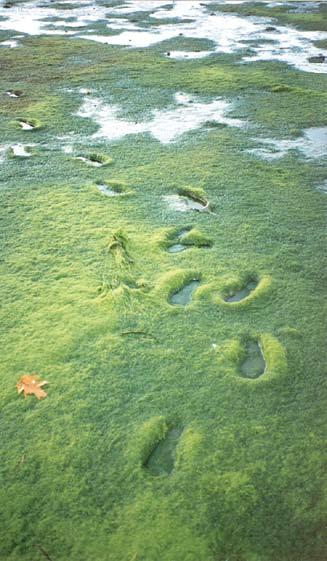
13 minute read
The Consequences of Overfeeding our Oceans
By Mary M. Cerullo and R. Michael Doan, Friends of Casco Bay
Too much of a good thing.
»Nitrogen pollution is on an insidious rise and is changing the very ecology of our oceans. We pump so much nitrogen into the ocean that the diverse array of microscopic plants that form the base of the food web are being replaced by nitrogen-devouring blue-green algae. And when life at the bottom of the food chain experiences such a dramatic shift, the entire system changes, all the way up to animals we like to eat, like scallops, clams, lobsters and fish. The constant deposition of nitrogen to our oceans is changing the fundamental structure of our marine ecosystem in ways we can’t predict, but are apt not to like.
Nitrogen is everywhere. It makes up 78 percent of the air we breathe and it is an essential nutrient that stimulates the growth of terrestrial plants. Healthy amounts of nitrogen are needed to jumpstart the growth of tiny plants that form the base of the ocean food chain, which nurture fish, clams, oysters, crabs, lobsters and whales. Rivers wash melting snow and rain, and the nutrients they carry, into our waters in a natural process that provides the ocean food web with a balanced diet, an alphabet soup of nutrients. Plants bloom, animals eat the plants and smaller animals are eaten by bigger animals. When all these organisms die, they are broken down by bacteria, recycling the nutrients to support the growth of new marine life.
But an overdose of nitrogen has tilted the cycle of life dangerously off balance. This overdose is killing the ocean as we know it. Two recent assessments of the health of the coastal oceans by the U.S. Commission on Ocean Policy and the Pew Oceans
An Evolutionary Step Backward
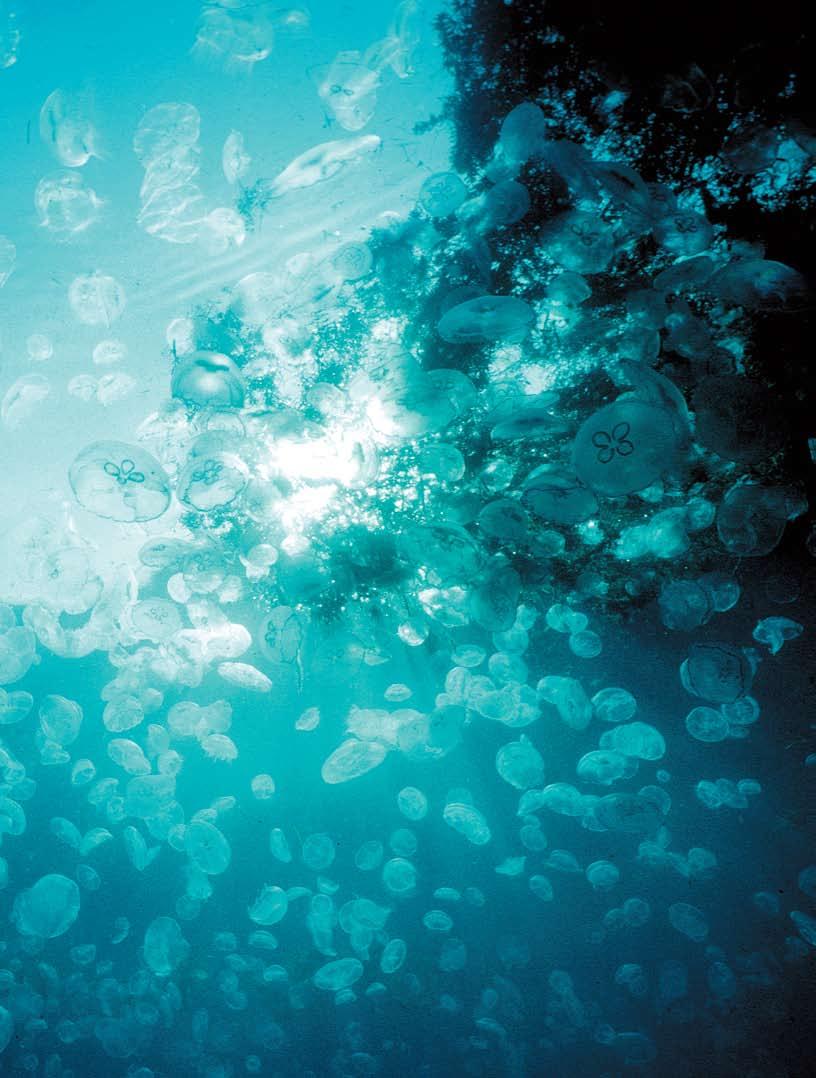
Moon jellies in the Caribbean Atlantic Ocean. As oxygen levels plummet jellyfish and other animals and plants adapted to low-oxygen environments take the place of the diverse, rich variety of sea life that used to thrive there. Scientists have called this shift “the rise of slime.”
Commission agree that nitrogen is a principal threat to the marine environment. Too much nitrogen triggers excessive growth of nuisance, even harmful, seaweed and algae. This organic matter eventually decays, consuming the oxygen dissolved in the water. And when dissolved oxygen goes, so does life.
Consider the Source Although nitrogen is extremely abundant in our atmosphere (about four times more plentiful than oxygen), only a fraction of the nitrogen on earth is in a form that is available to plants. A century ago, natural fixation by species of algae and leguminous plants, and lightening strikes, were the only way that the gaseous nitrogen could be converted to a form that could be used by plants. The absence of nitrogen limited plant growth on land and in the water.
In the 1950s, scientists were working to remove this limit to feed the burgeoning human population — enter the green revolution. By applying high pressure and temperature they were able to produce mass quantities of nitrogen fertilizer from nitrogen gas in the atmosphere. Today humans make as much nitrogen available to growing plants as Mother Nature does. This ability to manufacture large quantities of fertilizer has led to an imbalance of nitrogen in our environment.
Some of this excess nitrogen reaches our crops, but much of it pours into our coastal waters from rainstorms washing excess fertilizer from neighborhoods and farms. Nitrogen also seeps out of septic tanks and pours from sewage treatment plants and sewage overflow pipe discharges into our waterways. Emissions from tailpipes and smokestacks also introduce nitrogen into the ocean through atmospheric deposition.
Fast-growing algae are best adapted to take advantage of the excess nitrogen we are adding to our oceans. When the bumper crops of algae die, bacteria suck up the oxygen as they break down the detritus. This process creates dead zones where levels of dissolved oxygen are so low that they stress or kill marine life. Around the world there have been nitrogen-induced low oxygen events — called hypoxia — where fish have died by the millions or billions.
Today’s Oceans The number of dead zones in the ocean has been doubling every decade since the 1950s. The largest, in the Gulf of Mexico, is result of nutrient pollution from the Mississippi River and extends from the coast of Louisiana to Texas. It varies from 6,000 to 7,000 square miles, roughly the size of New Jersey. Commercially desirable fish leave these hypoxic dead zones.
Animals that are adapted to living in low-oxygen waters, such as jellyfish, appear to do fine in these dead zones. Moon and lion’s mane jellies are appearing in greater numbers and earlier in the season in Maine’s cold waters. As a result of a glut of jellyfish in 2002 that threatened salmon farms and swimmers alike, the Canadian province of Newfoundland and Labrador commissioned a study to assess the feasibility of developing a new fishery for jellyfish. Newfoundland’s fisheries department hoped that the stinging sea creatures could be harvested commercially for sale to Asian markets,
The ocean is in my blood. I always felt that we could sustain and protect it, but now I am terribly worried. The whole ocean ecosystem is under attack, and no one seems to be paying attention. All the signs are there. Manatees with blood streaming out of their noses are washing up on the coast of Florida. Crazed sea lions are biting people in San Francisco. Fishermen off the coast of North Carolina are pulling up nets filled with thick swarms of jellyfish. Right here in Casco Bay, some clam-flats are so thick with green slime that mussels and clams are being smothered. What will it take to get people to act? Casco Baykeeper Joe Payne
B aykeeper
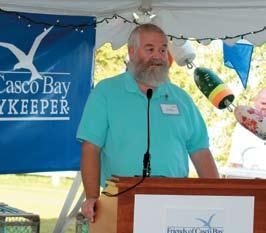
C asco
Casco Baykeeper Joe Payne has devoted his career to finding reasoned, science-based solutions for environmental threats to his part of the ocean realm, Casco Bay, a beautiful, bustling estuary in southern Maine.
A sign posted at Walker Creek in Essex, Massachusetts, prohibits shellfishing due to red tide in June 2005. That summer Governor Mitt Romney declared a state of emergency, allowing the state to seek federal disaster aid for the devastated shellfish industry.
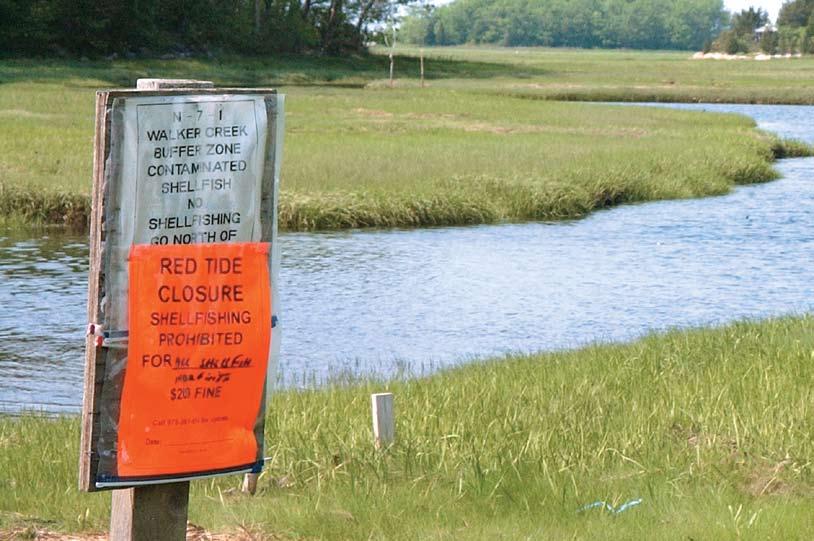
Animals that feed on these small aquatic organisms, such as birds, larger fish and marine mammals are affected by toxic algae. Eighty-eight manatees along the west coast of Florida died from red tide in 2005. They breathed the concentrated brevetoxin fumes at the water’s surface, which caused neurological and respiratory damage. This aerial view shows Coquina Beach, Florida, with an algae bloom in August 2006.

The Birds
On August 18, 1961, the Santa Cruz Sentinel (California) reported, “A massive flight of sooty shearwaters, fresh from a feast of anchovies, collided with shoreside structures from Pleasure Point to Rio del Mar during the night. Residents… were awakened about 3 A.M. by the rain of birds slamming against their homes… When the light of day made the area visible, residents found the streets covered with birds. The birds disgorged bits of fish and fish skeletons over the streets and lawns and housetops, leaving an overpowering fishy stench.”
The newspaper noted in a brief article three days later that the Hollywood producer Alfred Hitchcock, who owned a home nearby, had requested a copy of the article as research for his latest thriller. It seemed that he was preparing to film a short story by mystery writer Daphne DeMaurier that, ironically, dealt with an attack by millions of birds on a town in the England countryside. Hitchcock sited his classic movie, The Birds (1963), in a seaside California community. Scientists have attributed the probable cause of the bizarre behavior by seabirds near Capitola to domoic acid poisoning from a red tide algae bloom.
S o u ndkeeper
Waterkeepers around the U.S. operate pump out boats, collecting sewage from pleasure boats at marinas and at anchor. Long Island Soundkeeper operates five pumpout boats in cities along the sound. Last year alone, Soundkeeper’s Clean Boater Program prevented 40,000 gallons of raw sewage from entering Long Island Sound. Pumpout boat operators — including Jack Backer, pictured — play an important role by providing pollution prevention education to yacht clubs, commercial passenger boat captains, civic groups and the media.
I sland
L ong
which use processed jellyfish in a variety of meals. A similar shift away from traditional fisheries, such as shrimp, to jellyfish has also been considered along the Southeastern coast of the United States. With traditional fisheries disappearing, we may not have any choice but to develop a taste for jellies. Some scientists have compared today’s nitrogen-polluted waters to conditions in the primordial seas, when primitive life such as bacteria and jellyfish predominated. Jeremy B.C. Jackson, of Scripps Institution of Oceanography, calls this pattern of evolutionary regression “the rise of slime.”
Commercially valuable fish and other marine life are not the only ones to go; plant life that thrives in clear, clean ocean water is also disappearing. Sea grasses, for example, are the ocean nursery grounds for two-thirds of all commercially and recreationally important marine species. Sea grass beds are disappearing in many places, as they are shaded out by algae. Waquoit Bay in Massachusetts is a prime example of the problem. Since the 1950s, research on eelgrass and nitrogen pollution has allowed scientists to document the steady loss of important aquatic habitat. The connection is quite clear, as nitrogen pollution increases, eelgrass beds disappear. Today, eelgrass beds cover only a fraction of their historical area. In nearby Buzzards Bay, 65 percent of the historical eelgrass beds are gone. This loss of critical habitat has ramifications throughout the food web.
Some of the algae that are blooming contain potent poisons that can kill. Harmful algal blooms, commonly called red tides, are increasing around the world. Their proliferation can be blamed at least partially on nutrient pollution. Red tides have closed the U.S. Northeastern coast to shellfish harvesting in recent years. These closures and outbreaks of toxic microorganisms have created severe financial hardships for commercial fishermen and are a threat to coastal communities. Joe Payne talks about the “snowbirds,” people who escape Maine’s frigid winters and muddy springs by retreating to the coast of Florida. Some return home to the Northeast coughing and complaining of cold-like symptoms. What they are likely experiencing are the lingering effects of brevetoxin exposure, an airborne toxin found in red tides on the west coast of Florida. When there is a red tide outbreak, coastal communities see a stark rise in emergency room visits.
Domoic acid is an example of harmful, microscopic algae at its worst. Exposure to the powerful toxin that this algae produces causes memory failure, disorientation and even death. Domoic acid was first identified in 1988 when four Canadians died after eating contaminated mussels from Prince Edward Island. Survivors suffered permanent memory loss. Their illness is now called amnesiac shellfish poisoning. This same harmful algae caused the deaths of 21 large whales in the Gulf of Maine in July of 2003 and was suspected to have poisoned at least nine whales and dozens of seals along the coast of Maine later that same year. Domoic acid is now widespread throughout U.S. waters, from New England to the Gulf of Mexico and up the West Coast all the way to Alaska.
What can we do about it? Americans have a love affair with the coast. More than half the U.S. population lives in coastal coun
ties. Ocean managers and environmental advocates like Waterkeepers recognize that excess nitrogen in coastal regions is one of the principal threats to the environmental health of the oceans, but until everyone else recognizes this too, our coastal waters will continue to deteriorate. Joe Payne notes, “Coastal development has taken away the wetland plants that filter out the nitrogen before it gets into the ocean. Our activities directly impact the very resource we are crowding ever closer to enjoy.”
Data collected by Casco Baykeeper in its longterm water quality monitoring program was essential to identifying and documenting the problem. “You can’t convince elected officials, the general public and even other researchers that we are facing a serious nitrogen dilemma unless you have the data to back it up.” Using this data Casco Baykeeper pushed for a state law setting legal limits for nitrogen and other nutrients.
In June 2007, Maine enacted the law and directed the Maine Department of Environmental Protection to set nutrient limits for coastal waters in state law. The legislation, written by Friends of Casco Bay, instructs the department to work with wastewater treatment facility operators to figure out how to reduce nutrient pollution from sewage treatment plants.
Casco Baykeeper has also encouraged municipalities and ocean-going vessels to stop pollution before it starts. Casco Baykeeper has kept pressure on municipalities to remove their combined sewage overflows, which divert nitrogen-laden stormwater and raw sewage into the bay during heavy rains. And since 1995, Friends of Casco Bay has operated a pumpout boat that visits marinas and moorings to remove sewage from recreational boats. It has emptied more than 5,500 marine toilets, preventing 95,000 gallons of sewage from entering Casco Bay. During the same time, we have worked with marinas, town landings and boatyards, offering technical advice and encouragement to increase the number of shoreside sewage pumpout facilities.
Community education and outreach, such as Casco Baykeeper’s BayScaping campaign, also proves effective in stopping nitrogen from reaching our waterways. BayScaping encourages homeowners, municipalities and businesses to reduce their use of fertilizers and pesticides. Developed in partnership with the Maine Board of Pesticides Control, BayScaping recognizes the connection between your lawn, stormwater and downstream waterways. Homeowners who follow a sixstep plan of environmentally-friendly lawn care can become certified BayScapers. “Most homeowners don’t realize that what they put on their lawns often ends up in the ocean. Many don’t even know that the lawn and garden products they use contain different pesticides and fertilizers. BayScaping teaches homeowners how to grow a healthy lawn without chemicals.”
Over the course of the campaign, Casco Baykeeper has found that most people want to do the right thing. When people know their wastes are destroying the oceans, they are eager to find solutions.
I stock
Beware Phosphorus!
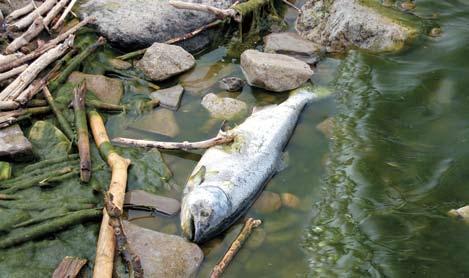
Nutrient pollution — primarily phosphorus — is a problem in freshwater. Toxic algae plaguing the Great Lakes and other lakes and streams across the country have health officials warning residents to keep their pets and themselves away from the water. Just as marine systems are limited by nitrogen, primary productivity in freshwater systems is limited by phosphorous. Most phosphorous is found as a component of rock, which over time weathers and is released into the environment, where it becomes available to plants as a nutrient. Phosphorous is extremely critical to life on earth. It is a primary part of DNA and ATP, the “energy currency” of all living things. Sources of excess phosphorous include fertilizers, wastewater, agricultural runoff and detergents. Excess phosphorous in the aquatic environment stimulates algae blooms.
A new Maine law restricts the sale of phosphorus-containing fertilizer. Beginning in 2008, retail stores must post a sign that indicates that fertilizers containing phosphorus threaten water quality of nearby lakes and rivers. It recommends that consumers avoid using fertilizer that contains phosphorus unless the user has done a soil test that shows that additional phosphorus is needed. Proponents had hoped to place a ban on selling lawn fertilizers containing phosphorus unless there was a proven need, such as if the purchaser is establishing a new lawn or reseeding an existing lawn or turf. Unfortunately, the law is just an educational message to consumers and lawn care professionals and does not contain enforceable restrictions on the application of excess phosphorus. Does your fertilizer have phosphorus? Look at the middle number describing the fertilizer blend (N-P-K); it should be zero.
In 2002, Minnesota became the first state in the nation to regulate the use of phosphorus fertilizer on lawns and turf. New Jersey, Florida, Wisconsin and Michigan have local ordinances.










